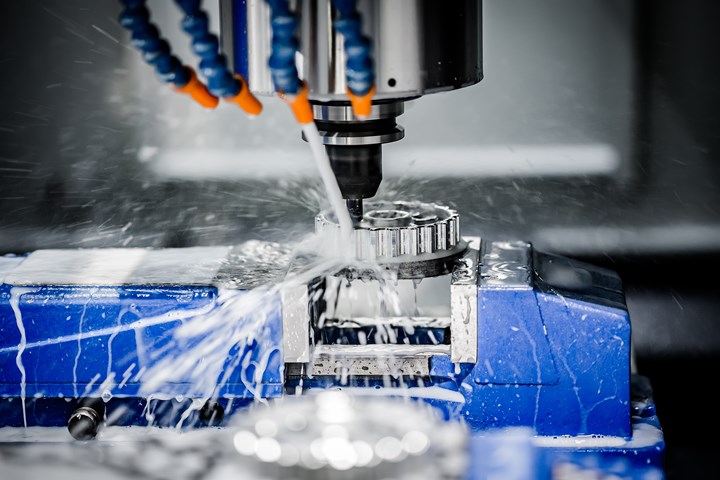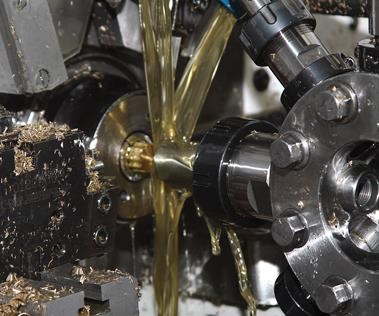Metalworking Fluid Management and Best Practices
Cutting metal is a complex process involving many critical factors to be successful. Correctly applied metalworking fluids, including oils or coolant, is one of these critical factors.
Metalworking fluids are complex chemical formulations tasked to perform multiple functions in the machining process. A high level of cutting performance is expected, along with excellent chemical and biological stability. Machine tool and part corrosion protection is a must as well as a high level of environmental health and human safety. With all these demands being placed upon a fluid, some degree of fluid maintenance is required.
Metalworking Fluid Types and Applications
Metalworking Fluids (MWF), also called metal removal fluids, are segregated into four main categories:
1. Neat oils (not mixed with water), also known as straight oils
2. Water miscible oils (macro emulsions or micro emulsions containing more than 30 percent oil) also known as soluble oils
3. Semi-synthetics (micro-emulsions) comprised of less than 30 percent oil content and less than 1 micron oil droplet size
4. Full synthetics, containing no oil (true solutions)
These fluid concentrates are comprised of various additives such as emulsifiers, anti-microbial pesticides, anti-oxidants, defoamers and stabilizers. Also a certain amount of water content may be present depending on the fluid type and its makeup. Base oils make up a large portion of the MWF concentrate and can also vary based upon the fluid type and formulation. Mineral oils (naphthenic oil) as well as bio-based oils (vegetable oils and esters) are used in water miscible and semi-synthetic fluids.
The following examples illustrate the various areas of use and applications of a straight oil versus a water soluble coolant.
Full synthetic coolants are based upon various glycols and have no oil content. The raw materials that make up metalworking fluid concentrates can vary in quantity and quality and are based upon what the fluid formulator/compounder selects. Each of these cutting fluids has various benefits and limitations and is recommended by the manufacturer based upon the customers’ expectations, application and the materials being machined.
The following examples illustrate the various areas of use and applications of a straight oil versus a water soluble coolant. An application and recommendation for neat oil would be in a Swiss-type machine. These machines generally have long production run times (lights-out machining), making large quantities of parts and metal chips. A fluid that produces a high level of lubricity is required for this type of machining operation, in order to provide maximum tool life and minimum downtime.
Machining operations and applications (such as milling or turning) where a large amount of metal is rapidly being removed function best with a water miscible (soluble oil) or semi-synthetic coolant because of the combined synergistic effect of the cooling and lubricating properties of water and oil.
Regardless of the fluid type and application, all fluids require some form of maintenance. Neat oils are relatively maintenance free fluids, but they do require some maintenance. Straight oils should be filtered on a regular basis to remove metal fines, which provides a high level of surface finish and cutting performance. Coolants, on the other hand, differ from straight oils by the fact that they require a higher degree of maintenance to provide years of high cutting performance, bio-stability and longevity.
When a metalworking fluid is mixed with water, a whole new level of potential problems is presented. The coolant sump is an excellent breeding ground for bacteria, fungi, yeasts and molds because it is dark, humid and provides an excellent nutrient source (the fluid itself) for bacteria to thrive on.
This problem can be exasperated by poor shop practices, such as machine operators introducing foreign substances into the fluid that don’t belong there. These foreign substances can promote the proliferation of various species of bacteria as well as the potential for pathogenic germ growth. Floor and glass cleaners can greatly influence the pH level of the fluid, causing chemical instability and metal attack.
For companies to realize the full potential of their metalworking fluids, a certain amount of maintenance is needed. These basic maintenance practices can greatly improve a fluid’s longevity, shop environment and the overall level of part quality.

Concentration is Key
All metalworking fluids are formulated to work within a specific concentration range. These working concentration limits are determined and recommended by the manufacturer for optimal fluid performance. All fluids have a “minimum concentration” level, which must be adhered to maintain bio-stability, good corrosion protection and cutting performance. If this concentration level is allowed to drop below the minimum level for any given length of time, various problems can arise. Bio-instability and bio-mass development, low pH, corrosion of ferrous alloys (red rust), emulsion splitting, poor cutting performance and ultimately the metal removal fluid disposal are some problems that can occur.
Coolant concentration is easily checked by means of an optical device called a refractometer. There are various types and styles of refractometers available for purchase, ranging from basic handheld optical refractometers to more sophisticated digital units. The best type of refractometer is one that is used regularly in the shop, as concentration is the most critical factor for optimal fluid life. Just remember the old adage, “You can’t control what you don’t measure.” If the concentration for a fluid is unknown for a specific application, it’s important to reach out to the fluid provider for this information.
Mixing Fluid Concentrates Properly
Metal removal fluids need to be mixed a certain way in order for their chemical makeup to be correct. The best way to remember the proper technique is by the acronym O.I.L. (Oil In Last). Always mix oil-based emulsions this way. Slowly introduce the fluid concentrate into the water while stirring vigorously, or purchase a proper coolant mixer.
Most fluid manufacturers sell or can recommend a decent coolant mixer for the shop’s needs. Good drinking water is highly recommended for mixing metalworking fluid concentrates. If the quality of available water is poor, water treatment may be necessary. Reverse osmosis (RO) and/or de-ionized water (DI) are excellent methods of water treatment and can greatly enhance the longevity of fluid life expectancy. Water quality is paramount for coolant stability; as excessively hard water can cause chemical instability and emulsion splitting.
Metalworking fluid providers can test the shop’s water quality to determine if it is acceptable for use. Keep this in mind: the largest component of the bulk fluid is water, typically 90 percent or more, so water quality has a major influence on coolant stability and longevity.
Tramp Oil Removal
Machine tools use various slideway lubricants and spindle oils for the lubrication of machine’s ways, ballscrews and spindle bearings. These oils are designed to provide hydrodynamic lubrication to the machine tool components, thus keeping interfacing metal surfaces apart.
Unfortunately, these oils ultimately end up in the coolant sump and thus contaminate the metalworking fluid. These tramp oils do not aid in the cutting process and can cause multiple coolant related issues.
Tramp oil mist increases residues on the machines’ exteriors and shop workplace surfaces, along with prematurely clogging air filters.
High levels of tramp oil in the metalworking fluid can cause an increased level of oil mist and smoke formation. Oil mist increases the potential exposure of bio-aerosols to personnel in the facility, thus making the shop environment potentially unsafe.
Tramp oil mist increases residues on the machines’ exteriors and shop workplace surfaces, along with prematurely clogging air filters. Oily residues can destroy sensitive electronic machine components and create unsightly brown residues on machine cabinet interiors.
High levels of tramp oil in the coolant increases the potential for anaerobic bacteria (requiring no oxygen) to establish a foothold in the coolant sump. This is done by providing an excellent food source for these microbes. Various anaerobes produce as a byproduct, H2S (hydrogen sulfide) gas. This gas is released when the sulfur components of the slideway lubricant and spindle lubes are metabolized by anaerobic bacteria.
The release of H2S gas into the atmosphere is an odor that most metalworkers are probably familiar with. It’s the noxious aroma of rotten eggs that is unaffectionately called Monday morning (Monday morning stink) when the coolant system is turned on after a shop floor has been idle for a weekend.
The interaction of the H2S and water along with anaerobic bacteria metabolites produces various acids. These acids drive the pH of the fluid down to a more acidic pH level. The lower acidic pH of the coolant can cause ferrous rust to form, as the acids attack the metal surfaces of the machine tool and parts.
If coolant concentration is below the recommended minimum, this process is accelerated. So as can be seen, tramp oil is a problem for metalworking fluids in general, and must be frequently removed from the coolant system. There are various methods of tramp oil removal equipment available on the market. These can range from simple disc and belt skimmers to more elaborate coalescers and high speed centrifuges. Any form of tramp oil removal is better than none at all and should be performed on a weekly, if not daily, basis.
Coolant Filtration
When metal is being removed, micron and sub-micron metal fines are produced. The metallurgical properties of these fines are changed during the cutting process and are now harder than the original material being machined.
If these metal fines are not addressed by means of filtration, they will be continually picked up by the coolant pumps and re-introduced onto the cutting zone, thus reducing overall tool life and poor surface finishes. These small fines can take hours to settle out of the fluid.
When they eventually do settle out, they produce a very dense mud on the bottom of the coolant sump. This mud tends to accumulate in stagnant areas, such as in the corners of the coolant sump and dead zones. This mud can build up to such a high degree that the bulk fluid and its additives (microbicides) are sealed off to the bottom layers. This, in turn, allows anaerobic bacteria and bio-films to form and creates an anoxic (no oxygen) environment in the sump.
Good filtration equals longer fluid life. In the past, the high cost of filtration media and equipment was prohibitive for most machine shops to realize a cost benefit. Now because of the high prices of metalworking fluids and the even higher costs of fluid disposal, all shops should be implementing some type of coolant filtration.
The level of filtration depends on the machining process and the desired level of surface finish. Thus the more critical the surface finish requirements, an equally increased level of fluid filtration is necessary. Filtration as low as 1 micron may be required in order to obtain super finishes less than 10 Ra.
In order for companies to realize the most return out of their machine tools and the increasingly expensive cutting tools they use, they must change their thinking about coolants in general. Metalworking fluids account for around 1 to 2 percent of the total cost of the part being manufactured, but can impact the overall manufacturing costs of the part by as much as 95 percent.
Instead of seeing coolant as a necessary evil, it should be viewed as an asset. Metalworking fluids are a liquid tool and should be treated as such. Taking proper care of them will increase a company’s productivity and profitability. Choose to neglect them, and it can cost the business dearly. Not a difficult decision.
Also read: “Sustainable Metalworking with Minimum Quantity Lubrication.”
Related Content
Video: Why a Production Machine Shop Started a Baseball Bat Company
A 153-year-old manufacturer of precision, metal pins recently started a side business creating custom wooden baseball bats. The reasoning behind establishing this new company is intriguing, as is how it has helped create a stronger bond with the local community.
Read More3 Common Filtration Questions Answered
Learn about the variety of filters for removing particulates from a cleaning fluid, how to determine cleaning fluid life and more.
Read MorePursuit of Parts Collector Spearheads New Enterprise
While searching for a small parts accumulator for Swiss-type lathes, this machine shop CEO not only found what he was looking for but also discovered how to become a distributor for the unique product.
Read MoreUnderstanding Micro-Milling Machine Technology
Micro-milling can be a companion process to turning-based production machining. This article looks at some of the technologies that go into a micro-milling machine and why they are important to successful operation.
Read MoreRead Next
Integrated Solutions for Chip Removal and Fluid Filtration
Shops can easily view chips simply as waste, hardly giving a second thought to the disposal process and the potential related savings. By keeping an eye on the waste and choosing the most efficient methods of chip disposal, a shop can easily add to the bottom line through substantial savings.
Read MorePreventing Metal Corrosion with Metalworking Fluids
All manufacturers deal with metal corrosion and rust. Learn about the causes of metal corrosion and options for preventing it.
Read MoreDo You Have Single Points of Failure?
Plans need to be in place before a catastrophic event occurs.
Read More













.jpg;maxWidth=300;quality=90)









